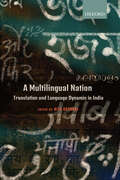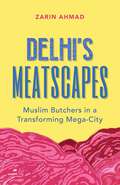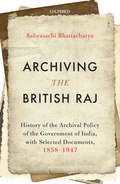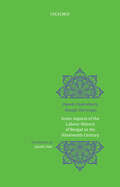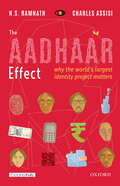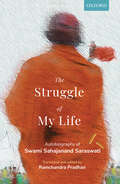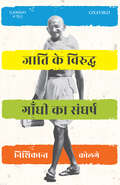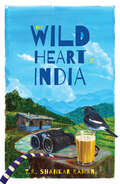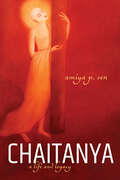- Table View
- List View
A Multilingual Nation: Translation and Language Dynamic in India
by Rita KothariHow does India live through the oddity of being both a nation and multilingual? Is multilingualism in India to be understood as a neatly laid set of discrete languages or a criss-crossing of languages that runs through every source language and text? The questions take us to reviewing what is meant by language, multilingualism, and translation. Challenging these institutions, A Multilingual Nation illustrates how the received notions of translation discipline do not apply to India. It provocatively argues that translation is not a ‘solution’ to the allegedly chaotic situation of many languages, rather it is its inherent and inalienable part. An unusual and unorthodox collection of essays by leading thinkers and writers, new and young researchers, it establishes the all-pervasive nature of translation in every sphere in India and reverses the assumptions of the steady nature of language, its definition, and the peculiar fragility that is revealed in the process of translation.
A Political History of Literature: Vidyapati and the Fifteenth Century
by Pankaj JhaMultilinguality gained a new impetus in North India with the influx of West Asian Muslim communities around the thirteenth century. Over a period of time, it entered everyday life as well as creative and scholarly pursuits. The fifteenth century, in particular, saw unprecedented vitality for literary practice, and the poet-scholar Vidyapati from Mithila was one of the many luminaries of the time. This volume encompasses an intimate linguistic, literary, and historical study of three of Vidyapati’s major works: a Sanskrit treatise on writing (Likhanāvalī); a celebratory biography in Apabhraṃśa (Kīrttilatā); and a collection of mythohistorical tales in Sanskrit (Puruṣaparīkṣā ). Through this examination, the author reveals a world that is marked by a range of ideas, expertise, literary tropes, ethical regimes, and historical consciousness, drawn eclectically from sources that belong to ‘diverse’ politico-cultural traditions. Using Vidyapati’s narratives, A Political History of Literature illustrates that many ideals extolled in fifteenth century literary cultures were associated with an imperial state—a state that was a century away from coming into being—and testifies that ideas incubate and get actualized in realpolitik only in the long duration.
Delhi’s Meatscapes: Muslim Butchers in a Transforming Mega-City
by Zarin AhmadTracing the journey of meat from the farm to the meat shop and other workspaces of the butcher within the multi-sited margins in Delhi, the current volume intimately follows the lives of Qureshi butchers and other meat sector workers in this transforming mega-city. The author addresses the tensions that meat throws up in a bristling society whose stakes are now more than ever intense. She shows how meat is also a rising sector in the Indian economy, and fetches precious foreign exchange. Qureshi butchers stand at the crossroads of class, caste, stigma, religion, market, urban ecological policies, and a never-ceasing political debate around these issues. Delhi's Meatscapes brings together rare archival documents, vernacular sources, and ethnographic insights gleaned from several years of immersion in the city's meatscapes and is the first of its kind for urban anthropologists, economists, political scientists, policy planners and readers who wish to take a hard look at their own (non-)meat choices.
Archiving the British Raj: History of the Archival Policy of the Government of India, with Selected Documents, 1858–1947
by Sabyasachi BhattacharyaThe archives are generally sites where historians conduct research into our past. Seldom are they objects of research. Sabyasachi Bhattacharya traces the path that led to the creation of a central archive in India, from the setting up of the Imperial Record Department, the precursor of the National Archives of India, and the Indian Historical Records Commission, to the framing of archival policies and the change in those policies over the years. In the last two decades of colonial rule in India, there were anticipations of freedom in many areas of the public sphere. These were felt in the domain of archiving as well, chiefly in the form of reversal of earlier policies. From this perspective, Bhattacharya explores the relation between knowledge and power and discusses how the World Wars and the decline of Britain, among other factors, effected a transition from a Eurocentric and disparaging approach to India towards a more liberal and less ethnocentric one.
India and the Interregnum: Interim Government, September 1946–August 1947
by Rakesh AnkitIndia’s interim government, in office from 2 September 1946 till August 1947, was a unique coalition of the Indian National Congress, All-India Muslim League, and non-Congress and non-League political figures—all presiding over a British/British-trained state apparatus during a period of political transition. These eleven months were packed as much with the events surrounding the formal exit of the empire as its informal continuance; as much with the anticipation of Partition as its alternatives. Though it stands at a juncture of India as a colony and a dominion, it has been overlooked by colonial and postcolonial historiography of that interval, given its sole identification with Partition/Independence. India in the Interregnum moves beneath and beyond this understanding in order to, first, restore identity to the interim government—and its provincial counterparts—and investigate their work, and, second, recover the legacy of the interim government in the formation of contemporary India.
Trends of Change in Bhakti Movement in Bengal
by Hitesranjan SanyalHitesranjan Sanyal’s Trends of Change in the Bhakti Movement in Bengal, despite remaining unfinished due to his untimely demise, is a seminal work on the devotional Bhakti movement. In this work the author spells out the multipronged and differential impact that Vaishnava Bhakti culture had on medieval Bengal and shows us how it aided the formation of the emotional world of the region.
Some Aspects of Labour History of Bengal in the Nineteenth Century: Two Views
by Dipesh Chakrabarty Ranajit Das GuptaDipesh Chakrabarty and Ranajit Das Gupta’s Some Aspects of the Labour History of Bengal in the Nineteenth Century presents a sharply posed conversation between them in October 1981 on working-class consciousness in Bengal. The arguments posited here show that rather than being a direct, mechanical outcome of the capitalistic mode of production, working class consciousness is a process. Asking questions about the morality of labour, history of peasant revolts, capitalist intervention, and so on, this is a classic work on labour history.
The Generation of Rage in Kashmir
by David Devadas2008, 2010, and 2016—three important points in recent history when mass rage emerged in Kashmir. But the reasons that pushed Kashmir to the brink on these three occasions were different from each other—from a perceived threat to identity, to rage over the killing of innocents, to support for militancy. If one looks closely, one could spot another important change: by 2016, a new generation of millennials had replaced those who had pelted stones in 2008. And, in a matter of a mere decade, the hope that was slowly permeating Kashmir suddenly collapsed and gave way to a new round of militancy. In this book David Devadas, a respected authority on Kashmir, delves into his deep understanding of the region and its youth to offer a unique understanding of the Kashmir issue. He relates the increase in the generation of rage in Kashmir to the inability of those in power to declare the end of militancy at the right time. Exploring vital aspects of the conflict economy, murders for rewards, and terror acts by state-backed mercenaries, Devadas shows how simplistic black-and-white narratives suit both pro- and anti-state actors equally and lead the poor and marginal to their deaths.
History and Theory of Knowledge Production: An Introductory Outline
by Rajan GurukkalWho decides what should be recognized as knowledge? What forces engender knowledge? How do certain forms of it acquire precedence over the rest, and why? Exploring these fundamental questions, this book provides an introductory outline of the vast history of knowledge systems under the broad categories of European and non-European, specifically Indian. It not only traces ontology and epistemology in spatio-temporal terms, but also contextualizes methodological development by comparing Indian and European systems of knowledge and their methods of production as well as techniques ensuring reliability. Knowledge cannot have a history of its own, independent of social history. Therefore, using a vast array of sources, including Greek, Prakrit, Chinese, and Arab texts, the book situates the history of knowledge production within the matrix of multiple socio-economic and politico-cultural systems. Further, the volume also analyses the process of the rise of science and new science and reviews speculative thoughts about the dynamics of the subatomic micro-universe as well as the mechanics of the galactic macro-universe.
Hindi Publishing in Colonial Lucknow: Gender, Genre, and Visuality in the Creation of a Literary ‘Canon’
by Shobna NijhawanInvestigating the emergence of Hindi publishing in colonial Lucknow, long a stronghold of Urdu and Persian literary culture, Shobna Nijhawan offers a detailed study of literary activities emerging out of the publishing house Gaṅgā Pustak Mālā in the first half of the twentieth century. Closely associated with it was the Hindi monthly Sudhā, a literary, socio-political, and illustrated periodical, in which Hindi writings were promoted and developed for the education and entertainment of the reader. In charting the literary networks established by Dularelal Bhargava, the proprietor of Gaṅgā Pustak Mālā and chief Edited by of Sudhā, this volume sheds light on his role in the development of Hindi language and literature, creation of canonical literature, and commercialization and nationalization of books and periodicals in the north Indian Hindi public sphere. Using vernacular primary sources and drawing on scholarship on periodicals and publishing houses as well as Edited by-publishers that has emerged over the past two decades, Nijhawan shows how one publishing house singlehandedly impacted the role of Hindi in the public sphere.
The Crises of Civilization: Exploring Global and Planetary Histories
by Dipesh ChakrabartyThe world created by the legacies of empire and colonialism now confronts some deep crises of civility, precipitated by globalization and climate change. In this volume, Dipesh Chakrabarty examines these distinct—but interrelated—issues side by side. Varied ideas of civilization and humanism have shaped notions of a global humanity in the lingering twilight of the European empires. Detailing these ideas, in the section titled ‘Global Worlds’, Chakrabarty outlines the conflicts and connections that arise from global encounters in our postcolonial age. The second section, ‘The Planetary Human’, on the other hand, explores the significance of planetary climate change for humanistic and postcolonial thought. Chakrabarty argues that such change demands not only critiques of capitalism and inequality, but also new thinking about the human species as a whole—our patterns of justice, writing of history, and relationship with nature in the age of the Anthropocene. The global is human-centric in construction; the planetary involves many other actors and thus includes the thorny question of how we go beyond the anthropocentric to discuss and conceptualize the agency of the non-human.
The Aadhaar Effect: Why the World’s Largest Identity Project Matters
by N.S. Ramnath Charles AssisiIdentification vs profiling; state welfare vs state surveillance; privacy vs transparency—Aadhaar has bitterly polarized India since its launch in 2010. No other project has captured the imagination of the people—or inspired such awe and anxiety—in recent memory. Aadhaar began life with a singular mandate: offer an identity to those Indian residents who didn’t have any. Along the way, it evolved into the welfare state’s flagship technology and altered forever how government, business, and society interact. The Aadhaar Effect is the story of the visionaries—bureaucrats, technologists, activists—who created or challenged India’s biggest juggernaut. It is equally the story of humans conflicted about complex choices that may make the world a better place. Polestar award winners N.S. Ramnath and Charles Assisi dive deep into the 12-digit number that has touched 1.2 billion lives and counting—and in the bargain, made the world sit up and take note of India’s ambition.
Pulayathara
by Paul ChirakkarodeThe idea of a home is at the heart of Pulayathara, which is not only the first Dalit novel on record (1963) but also one of the founding texts of the Dalit Christian movement in Kerala. It opens with a near vision of Thevan Pulayan’s intense attachment to land; it then leads on to his displacement after decades of devoted service to his upper-caste landlord who, overnight, deprives him of both home and livelihood. Beginning with Pulayathara, the theme that runs through all of Chirakkarode’s works is casteism in Christianity: the role of the Church in the continued enslavement of the Pulayar and the psychological effect it has on a people who abandon their ancestral gods to embrace the new faith. Without a doubt, the Dalit converts for physical and emotional security as well as survival. However, inevitably, disenchantment follows and the search for ‘home’ continues. Is the Dalit Christian any better off than he was before conversion?
Transregional Trade and Traders: Situating Gujarat in the Indian Ocean from Early Times to 1900
by Edward A. Alpers Chhaya GoswamiBlessed with numerous safe harbours, accessible ports, and a rich hinterland, Gujarat has been central to the history of Indian Ocean maritime exchange that involved not only goods, but also people and ideas. This volume maps the trajectory of the extra-continental interactions of Gujarat and how it shaped the history of the Indian Ocean. Chronologically, the volume spans two millennia, and geographically, it ranges from the Red Sea to Southeast Asia The book focuses on specific groups of Gujarati traders, and their accessibility and trading activities with maritime merchants from Africa, Arabia, Southeast Asia, China, and Europe. It not only analyses the complex process of commodity circulation, involving a host of players, huge investments, and numerous commercial operations, but also engages with questions of migration and diaspora. Paying close attention to current historiographical debates, the contributors make serious efforts to challenge the neat regional boundaries that are often drawn around the trading history of Gujarat.
The Struggle of My Life: Autobiography of Swami Sahajanand
by Ramchandra PradhanSahajanand Saraswati (1889–1950) was a man of many parts. Monk, scholar, freedom fighter, and leader of the peasant movement, he made an impact in all these spheres. His autobiography, Mera Jeevan Sangharsh (‘The Struggle of My Life’), gives an account of his life and his attempts to reform the ills besetting his country, in religion and in politics. In doing so, it sheds light on a number of significant periods in the history of India. It is, however, the tale of the nation told from the margins, not from the perspective of the English-educated, vilayat-returned nationalist. It is written by a man with humble roots who decided to improve the life of the common masses. This is an especially relevant book in these times, when the aam aadmi has become the pivot on which election campaigns are run and won. The Struggle of My Life chronicles the remarkable life of a man who lived in remarkable times.
Jawaharlal Nehru
by Rudrangshu MukherjeeAfter more than seven decades of Independence, Jawaharlal Nehru (1889–1964) is still an overarching presence in India’s collective memory. One of the central figures in the country’s freedom struggle, he was also an eminent writer. This short introduction to Nehru traces his personal–political journey from being a rich, Westernized young man to a radical leader of the Indian National Congress. Mukherjee provides a glimpse of his relationship with Gandhi—fraught with major ideological differences but steeped in mutual love and respect. Detailing the principles he stood by, the volume examines his role in the birth of a fledgling nation as well as his contribution as the first prime minister of the country in putting place the basic democratic structure of the Indian polity and society.
Shooting a Tiger: Big-Game Hunting and Conservation in Colonial India
by Vijaya Ramadas MandalaThe figure of the white hunter sahib proudly standing over the carcass of a tiger with a gun in hand is one of the most powerful and enduring images of the empire. This book examines the colonial politics that allowed British imperialists to indulge in such grand posturing as the rulers and protectors of indigenous populations. This work studies the history of hunting and conservation in colonial India during the high imperial decades of the nineteenth and early twentieth centuries. At this time, not only did hunting serve as a metaphor for colonial rule signifying the virile sportsmanship of the British hunter, but it also enabled vital everyday governance through the embodiment of the figure of the officer–hunter–administrator. Using archival material and published sources, the author examines hunting and wildlife conservation from various social and ethnic perspectives, and also in different geographical contexts, extending our understanding of the link between shikar and governance.
An Endangered History: Indigeneity, Religion, and Politics on the Borders of India, Burma, and Bangladesh
by Angma Dey JhalaAn Endangered History examines the transcultural, colonial history of the Chittagong Hill Tracts, c. 1798–1947. This little-studied borderland region lies on the crossroads of Bangladesh, India, and Burma and is inhabited by several indigenous peoples. They observe a diversity of religions, including Buddhism, Hinduism, animism, and Christianity; speak Tibeto-Burmese dialects intermixed with Persian and Bengali idioms; and practise jhum or slash-and-burn agriculture. This book investigates how British administrators from the eighteenth to mid-twentieth centuries used European systems of knowledge, such as botany, natural history, gender, enumerative statistics, and anthropology, to construct these indigenous communities and their landscapes. In the process, they connected the region to a dynamic, global map, and classified its peoples through the reifying language of religion, linguistics, race, and nation.
Administering Colonialism and War: The Political Life of Sir Andrew Clow of the Indian Civil Service
by Colin R. AlexanderColonialism is a dehumanizing experience for all those at the mercy of its power structures. The officers of the Indian Civil Service (ICS) were no exception. This book focuses on the role of ICS in World War II and engages in a wider debate about colonialism’s impact on its administrators and subjects. The author looks at the events of World War II specifically in the province of Assam in India’s North-East. It is here that the British and American troops were stationed as they attempted to retake Burma following Japan’s invasion in 1942 and supply the Allied Chinese by road and air. The volume also focuses on how radio broadcasting was used to manufacture the Indian public’s consent for the war effort and explores the horrors of the Bengal Famine and the controversies surrounding the British responses to it. The central character in the book’s narrative is Sir Andrew Clow who was a career civil servant in India. He was the Minister for Communications during the late 1930s and early 1940s before he became the Governor of Assam in 1942. The book is partly a biography of his fascinating career.
Gandhi after 9/11: Creative Nonviolence and Sustainability
by Douglas Allen9/11 marked the beginning of a century that is defined by widespread violence. Every other day seems to be a furthering of the already catastrophic present towards a more disastrous tomorrow. With climate change looming over us, frequent economic instability, religious wars, and relentless political mayhem, life for what we have made of it seems more and more unsustainable. Douglas Allen insists that we look to Gandhi, if only selectively and creatively, in order to move towards a nonviolent and sustainable future. Is a Gandhi-informed swaraj technology, valuable but humanly limited, possible? What would a Gandhian world—a more egalitarian, interconnected, decentralized—of globalization look like? Focusing on key themes in Gandhi’s thinking such as violence and nonviolence, absolute truth and relative truth, ethical and spiritual living, and his critique of modernity, the book compels us to rethink our positions today.
Jaati ke Viruddh Gandhi ka Sangharsh
by Nishikant KolgeIn 1909, while still in South Africa, Gandhi publicly decried the caste system for its inequalities. Shortly after his return to India though, he spoke of the generally beneficial aspects of caste. Gandhi's writings on caste reflect contradictory views and his critics accuse him of neglecting the unequal socio-economic structure that relegated Dalits to the bottom of the caste hierarchy. So, did Gandhi endorse the fourfold division of the Indian society or was he truly against caste? In this book, Nishikant Kolge investigates the entire range of what Gandhi said or wrote about caste divisions over a period of more than three decades: from his return to India in 1915 to his death in 1948. Interestingly, Kolge also maps Gandhi's own statements that undermined his stance against the caste system. These writings uncover the 'strategist Gandhi' who understood that social transformation had to be a slow process for the conservative but powerful section of Hindus who were not yet ready for radical reforms. Seven decades after it attained freedom from colonial powers, caste continues to influence the socio-political dynamics of India, and Gandhi against caste—the battle is not over yet.
The Wild Heart of India: Nature and Conservation in the City, the Country, and the Wild
by T.R. Shankar RamanWild—untamed, hostile, remote. Yet, wild can be gentle, welcoming, and inspiring, too. This is the wild that preoccupies biologist Shankar Raman as he writes about trees and bamboos, hornbills and elephants, leopards and myriad other species. Species found not just out there in far wildernesses—from the Thar desert to the Kalakad rainforests, from Narcondam Island to Namdapha—but amid us, in gardens and cities, in farms, along roadsides. And he writes about the forces that gouge land and disfigure landscapes, rip trees and shred forests, pollute rivers and contaminate the air, slaughter animals along roads and rail tracks—impelling a motivation to care, and to conserve nature. Through this collection of essays, Shankar Raman attempts to blur, if not dispel, the sharp separation between humans and nature, to lead you to discover that the wild heart of India beats in your chest, too.
Colours of Loneliness and Other Stories
by Paramita SatpathyThis is a collection of fourteen short stories by Paramita Satpathy. These stories are full of characters that conceal their true persona under a veneer of a false confidence who are then are driven to seek a state of euphoria, releasing these dormant passions in unguarded moments. We have characters like Maya, whose life seems to upend the moment spots appear on her body. On the other hand, for her best friend Veena, life seems to be most sorted. Everyone seems to pity Maya, and she longs to be included, to belong. Yet as the years progress, it is Maya who has created a stable life for herself, while Veena is left wondering where she went wrong in life. There is also Babula, the orphan, who has to bear with whatever abuse Bata Sahu throws at him, in order to survive, and his struggle to break free from it. Prachi, the bride-to-be, who discovers her fiancé’s true animalistic nature; and Ranjita, the new bride who becomes the ultimate pay-off for her in-laws’ greed. For some protagonists, it’s the societal shackles they need to break out from; for others it is their own closest relations that compel them to take a bold step towards self-realization.
A Social History of Christianity: North-west India since 1800 (Oxford India Paperbacks)
by John C.B. WebsterThe Christian community in India emerged from an Indian rather than a foreign or an imperial context. Its internal dynamics were shaped far more by Indian social realities than by missionary designs. This book presents a comprehensive social history of Christianity in north-west India, comprising Jammu and Kashmir, Himachal Pradesh, Punjab, Haryana, the Union Territories of Delhi and Chandigarh, and the Pakistani Punjab and North-West Frontier Province. The book discusses significant events in the history of the north-west up to 1947, after which it focuses only on India. These events left a lasting impact on Christianity and shaped its future course, culminating in the transfer of churches’ power from foreign missionaries to Indians and proliferation of churches, and the ongoing struggles of the Christian community. The author pays special attention to the Christian community’s caste composition—how caste status and social mobility affected intra- and inter-community relations—religious diversity, uneven demographic distribution, and development, as well as Christianity as a religious movement in the region.
Chaitanya: A Life and Legacy
by Amiya P. SenA saint, a reformer, an avatar of Lord Krishna—Chaitanya Mahaprabhu (1486–1533) is perceived as all these and many others. In this book on Chaitanya, Amiya P. Sen focuses on the discourses surrounding the mystic’s life, which ended rather mysteriously at the age of 48. Written in a lucid manner and for a wider audience, this book is a fresh attempt to historically reconstruct Chaitanya’s life and times in Bengal and Odisha, as well as Vrindavan, the key centre of medieval Vaishnavism in north India. This work critically evaluates how Chaitanya has been understood contemporaneously and posthumously, particularly as an icon in colonial Bengal. Addressing an important gap in scholarship, which hitherto concentrated on religious and philosophical discourses, Sen offers a full-length biographical account of Nimai or Gaur by drawing on a wide range of sources in English and Bengali. He also argues against the belief that Chaitanya is the sole proponent of Vaishnava bhakti in Bengal, choosing to situate him in the wider devotional cultures of the region.
